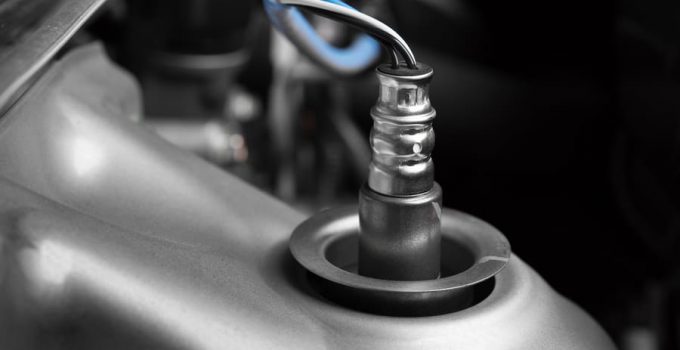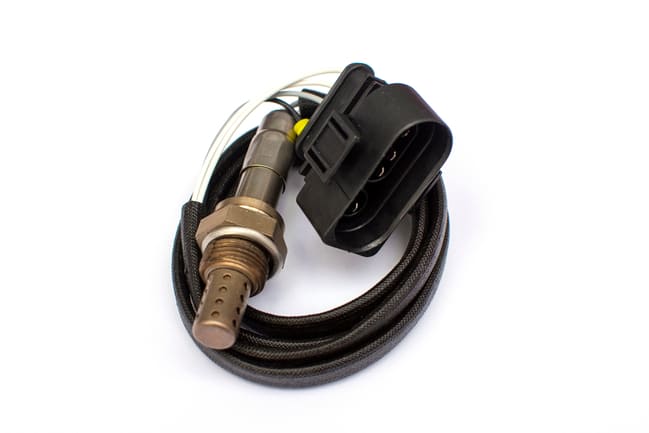
With the help of the lambda probe, the engine control unit receives specific information on fuel combustion. These are essential to control the fuel injection in such a way that not only engine performance but also fuel consumption can be optimized. The parameter that said component measures is the oxygen content in the exhaust gases emitted from the combustion chambers. This residual oxygen content allows a statement to be made as to how completely the fuel could be burned. Depending on the value, the fuel quantity can then be adjusted in the injection process. The installation position of the lambda probe is usually just behind the exhaust manifold, which transfers the engine exhaust gases to your exhaust system for aftertreatment. Finally, the residual oxygen content also determines how good the exhaust aftertreatment in the catalytic converter is. This requires a certain minimum amount of oxygen to function correctly.
Contents
Structure and functionality of your lambdaprobe

Before you can learn to tell if the lambda sensor is defective, you need to understand this component better. Their function is reflected in the structure of the lambda probe. In principle, the measured value determined by this device is a so-called comparison value. It is assumed that the oxygen content of the normal ambient air is around 20.8%, whereas the exhaust gases should only contain 0.3% to a maximum of 3%. This results in different voltage values, which the engine control unit can evaluate. So you have to change the lambda probe in the car if the measured values no longer match the actual values. In general, a broken component no longer supplies 0.1 V with a fuel-poor (lean) mixture. This value results when the residual oxygen content is comparatively high at 3%. The more fuel-rich (richer) the combusted mixture, the higher the generated voltage difference. The value can rise to 0.9 V. If the voltage of your lambda probe is much too high, this can even lead to particularly expensive damage to the engine control unit. There are often several components of this type in a modern car, but if one of them is defective, you should know that it cannot be repaired. The only way you usually have to get the component running again is to clean the lambda probe. You should always check the measuring device when you check your exhaust system. The usual test interval is usually around 30,000 km.
What different types of lambda sensors are used?
As a rule, two different principles are used. There are both resistance jump probes and voltage jump probes. The latter use zirconium dioxide as the central solid electrolyte. This becomes permeable to oxygen ions from about 300 °C. Because a platinum electrode is attached to both sides and the exhaust gases pass on one side and the reference air on the other, an ion exchange occurs. Your engine control unit can use the resulting voltage to optimize various engine parameters. The alternatively usable resistance jump lambda probes differ in that the ceramic middle element consists of a titanium dioxide material. Its resistance is proportional to the residual oxygen content of your exhaust gases. The conductivity drops when the oxygen content is high and increases when the mixture becomes richer and the residual oxygen content is lower.
A particularly modern type is the so-called broadband lambda sensor. This has a comparable structure, but there are additional elements, such as a pump cell, which has a small passage to the diffusion cell. In principle, this design allows the fuel-to-air ratio to be adjusted as desired, whereas the classic measuring probes are designed to achieve an exactly stoichiometric ratio and the most complete possible fuel combustion.
Another innovation is the so-called lambda probe heating, which was not present in the first components of this type. In the beginning, the measuring probes always had to be installed as close as possible to your engine block in order to reach the necessary operating temperature as quickly as possible. Of course, this caused a significantly higher thermal load, so that these components had to be replaced particularly frequently. With the help of the lambda probe heater, the measuring sensors can now be installed at thermally better protected locations, because the heater can generate the precisely required temperature.
What are the symptoms of a defective lambda probe?
The basic causes that lead to a component malfunction are short circuits, dirt, defects in the power supply, leaded fuel or additives as well as overheating and mechanical damage. As a driver, you will usually first notice an increase in fuel consumption or reduced engine performance. A defective lambda sensor sometimes even leads to misfires. If you determine a failure of this component, you should always try to clarify the cause, because it is not uncommon for you to identify fundamental problems that can lead to far greater damage. Regular checks like this can significantly extend the life of your engine.
How can you check your lambda probe yourself?

Unfortunately, it is not quite as easy to check this component as it is in a specialist workshop. The workshop can use either a special lambda probe tester or an exhaust gas test bench. As a hobby mechanic, you have a good chance, at least with the multimeter, of detecting serious defects in the lambda sensor. As always, you should start with a visual inspection. In this way you can detect deposits, cable defects or damage or sooting of the probe protection tube. Deposits often form when oil gets into the combustion chambers (e.g. due to defective piston rings) or when you use unsuitable fuel additives.
The next step is an electronic check. You connect your modern, fast-reacting digital multimeter to the lambda probe (red) and the ground of the vehicle (black). The measuring range should be in the range of 1-2 volts DC. Turn on your ignition and the engine is still cold, the probe voltage should be around 0.45V. If your vehicle engine is then at operating temperature, the measured values should be in the range of 0.1 to 0.9 V and oscillate. The optimal engine speed is about 2500 revolutions per minute. If your component has an integrated heater, you should measure both the voltage supply from the vehicle (about 10 V on the white cables) and the internal resistance of the heater (2 to 4 Ω between the white cables).
Conclusion
Lambda sensors are important components that not only help to optimize your exhaust aftertreatment, but also the injection behavior of your engine. This brings more engine power, lower fuel consumption and increases the environmental friendliness of your vehicle. In the event of a possible defect, you should therefore act as quickly as possible. If you discover a possible defect, you should replace it (or have it replaced) as soon as possible. For the same reasons, you should also clean your particle filter regularly and check its function.
A tip from CarTipsandmore: Some vehicles have several components of this type that can fail independently of one another. In addition, you should always keep in mind that if you replace components in your exhaust system, you may also need a new measuring probe. This is mostly due to the fact that it usually cannot be removed without damaging a rust-affected exhaust.
